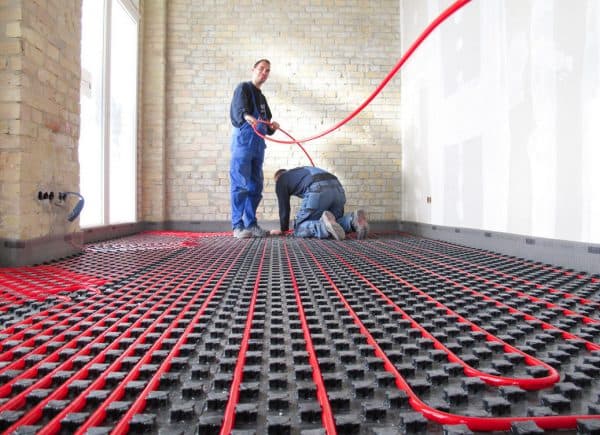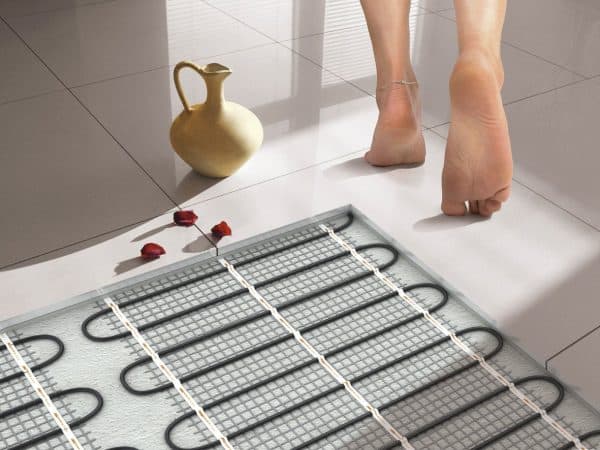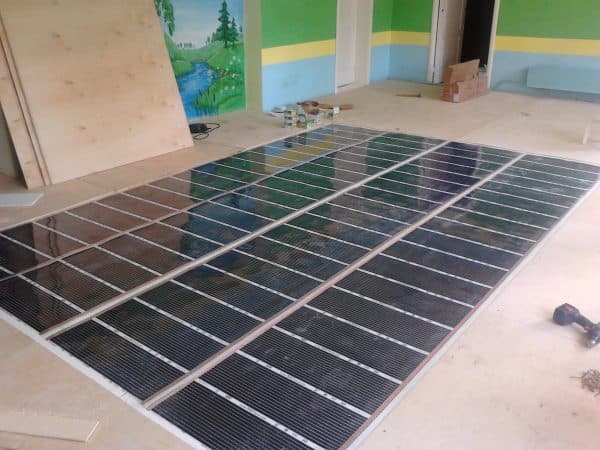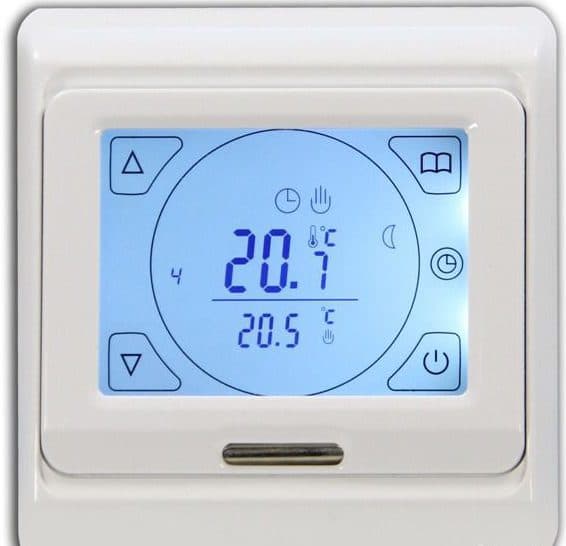Arranging a modern home is an exciting experience. So many things have been thought up for comfort and convenience. Warm floors are a vivid example of improving living conditions in an apartment or private house. Their installation allows you not to depend on the season, weather outside the window and other circumstances.
Types of warm floors
The choice of the type of underfloor heating depends on personal preferences, the characteristics of the room and financial capabilities. In addition, each of the types has both advantages and disadvantages. So, everything in order …
Water floor
The water floor is arranged according to the principle of a horizontal heating system. Pipes from Rehau or another manufacturer are laid directly into the floor screed, through which hot water circulates. It acts as a coolant, heating the surface. The result is a warm floor.

This is what a water floor looks like
The water floor has a number of advantages over others:
- relative cheapness of operation;
- the ability to partially or completely replace central heating.
There are a little more disadvantages. Among them:
- the complexity of the installation of the pipeline system;
- the high cost of work and materials for the installation of such a floor;
- in a situation where the pipes are not located correctly, “cold zones” appear. There is only one method to avoid the problem – tight pipe laying;
- large load on the network and wiring with an increase in the length of the pipeline.
It is forbidden to connect the water heated floor to the central heating system. This will drastically reduce the power and pressure maintained in the heating infrastructure of an apartment building. As a result, the top floors run the risk of being left without heating.
Electric floor
An alternative to a water-heated floor is electric. The essence of the work of such a floor is the heating of a cable made of special components. The cable is laid in a tie and connected to the power supply system. It can be used both as a constant heat source and for the purpose of periodic, auxiliary heating.

This is what a built-in electric floor looks like.
The main feature of such a floor is the ability to adjust the exact temperature and the time of continuous operation. The installation of an electric underfloor heating provides for the possibility of connecting a control system and a timer. With their help, all parameters of the warm floor are adjusted.
Infrared floor
The “youngest” type of warm floor. The heat carrier is a special thermal film. It is able to heat up from the mains, transferring heat to the surface. One of the main differences from other types is that such a floor is not located in the screed, but below the last layer of the coating.

Installation of infrared floor
This eliminates the need to disassemble the entire flooring system in the room. In addition, the top coat heats up quickly and instantly creates a warm floor effect. This type is considered the most environmentally friendly and effective.
Benefits of electric and infrared floors for the home
Electric and infrared underfloor heating is more modern and more popular than water. They have their disadvantages, but the advantages overlap them significantly . Like any other system, an electric underfloor heating has advantages:
- ease of installation;
- comfortable, uniform heat distribution over the surface;
- low cost of materials for installing such a floor;
- the ability to install control systems, which allows you to turn on / off the heating;
- reliability, long service life
Among the advantages of infrared underfloor heating:
- installation does not require a radical change in the structure of the floor;
- maximum floor heating speed;
- installation is carried out above the screed, which makes it possible to install an infrared floor during cosmetic repairs;
- high efficiency due to the ability to convert almost 100% of energy into heat;
- breakdown of part of the infrared floor installation does not entail failure of the entire system;
- system security;
- completely environmentally friendly option, no radiation.
How to choose a water meter can be found by clicking on this link.
How to calculate the electricity consumption for the floor?
It should be noted right away that it is impossible to accurately calculate the cost of electricity for the maintenance of a warm floor. This is due to the fact that there are too many factors affecting heat transfer and heat preservation in the room.
We will demonstrate an approximate calculation with an example.
Let’s say that you have purchased a floor heating system with a capacity of 160 watts per 1 sq. M. The area of the heated room is 10 sq. M. Let’s convert units of measurement: 160 W = 1.6 KW. With constant operation of the warm floor for 8 hours continuously, 12.8 kW will run. Thus, for a month of operation in this mode, we get 384 kW.
When installing a thermostat, this indicator will be significantly reduced.
In order not to be mistaken in the calculation, pay attention to the data on the purchased underfloor heating system. The packaging most often says how much electricity it consumes.
What affects energy consumption?
As noted, there are a number of factors affecting the electricity consumption during the operation of a warm floor. These are:
- the difference in the use of underfloor heating sporadically and constantly;
- the difference in the thermal insulation of the premises. The dependence is simple: the higher it is, the less electricity will be needed;
- season and air temperature outside the windows. The colder it is, the more electricity costs for floor heating;
- difference in flooring. Tiles, for example, take longer to warm up than other coatings;
- the frequency of family members’ stay at home. The more often someone is at home, the more often the warm floor turns on, therefore, more electricity is consumed;
- The warmth of the household. Among the tenants there are “frozen” people who like to make it hot. In this case, the energy consumption increases;
- the difference between the installed thermostats.
What factors should be taken into account during installation so that the energy consumption is less?
Installation of underfloor heating does not tolerate an amateur approach. Here you need to think carefully about everything so that later you do not overpay for electricity consumption. What must be taken into account during installation in order to minimize energy costs:
- it is advisable to install any kind of underfloor heating system only on 70% of the room area . Everything is simple: under a covering occupied by large furniture plus 10 cm from it, you should not carry out a warm cable or thermal film. This part of the floor does not need heating, and the overall heat transfer will not be affected;
- thermal insulation of the room. Before installing a warm floor, it is worthwhile to deal with the elimination of a blemish in the thermal insulation of the room. In drafty rooms, heat evaporates faster;
- take care of the installation of the regulator in advance . With its help, you can reduce the heating power, thereby saving on electricity;
- when installing a warm floor, it is better to provide for the accompanying installation of a heat-insulating substrate.
Balsa underlayment can save up to 45% on energy costs.
What materials to use for a warm floor can be found in this article.
How to save energy consumption of underfloor heating?
To save on the energy consumption of a warm floor, you need to reduce heat loss. To eliminate unnecessary costs, it is enough to adhere to the rules:
- regulate heat consumption depending on the need. If the heating temperature gets too high, it will be uncomfortable and unpleasant to walk on the floor. The air in the room also overheats. You need to regulate the temperature wisely. This will make the use of underfloor heating pleasant and will save on electricity;
- to seal up all heat leaks at home. The energy consumption from the warm floor is less if the thermal insulation of the room is close to ideal;
- set the minimum temperature for maintaining the system when no one is at home. It is better to turn off the warm floor in case of a long absence of tenants. In other cases, it is more efficient to set the mode of maintaining the minimum heating temperature;
- do not put underfloor heating at maximum load. Setting the maximum possible temperature increases the consumption of electricity;
- adjust the operation of the ventilation hood. If the room is not properly ventilated, heat losses can increase by one third.
What are thermostats and why are they needed?
Thermostats are installed in addition to the underfloor heating system. They allow you to control all processes related to heating, switching on, off, maintaining temperature, etc.

Underfloor heating thermostat
Some models allow the system to be turned off automatically when the floor is hot enough. Thus, while it cools down, electricity is not consumed. As soon as the temperature drops to a certain level, heating resumes. This allows you to spend 3 times less electricity than without a thermostat.
If it has the ability to program, energy consumption is reduced by another 1.5 times. This happens by setting the desired temperature for a certain period of time.
The newest thermostats are equipped with a sensor that allows you to see and control the temperature of floor heating and many other parameters.
When buying a warm floor, it is better to pay special attention to the thermostat. It is definitely not worth saving, since the costs for it will be completely covered by the savings in the future.
Thus, installing a warm floor is an excellent solution to improve the heating system at home. Electric and infrared types of underfloor heating have many advantages. Among the shortcomings, there is only one significant one – an additional payment for electricity. However, with proper, intelligent use, cost savings can be achieved. In this case, the warm floor will bring joy and pleasure.
